

*Dr. V's Interview with Jennifer Casa-Todd. *Moving from Digital Citizenship to Leadership. A few days ago, my 15 year old had an interview over Skype for a camp counsellor position.
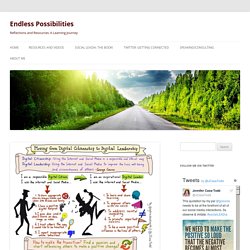
She was extremely nervous, as could be expected, as it was her first interview ever. So we thought of some possible questions together and she practiced how she would answer. The Optimistic Heart of Digital Citizenship. Nine Elements. 2.
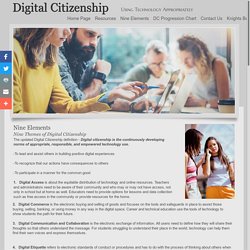
Digital Commerce is the electronic buying and selling of goods and focuses on the tools and safeguards in place to assist those buying, selling, banking, or using money in any way in the digital space. Career and technical education use the tools of technology to show students the path for their future.3. Digital Communication and Collaboration is the electronic exchange of information. All users need to define how they will share their thoughts so that others understand the message. What New Research on Teens and Social Media Means for Teachers. As teachers, we all have assumptions -- and likely some opinions -– about teenagers and social media.
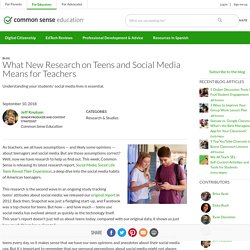
But are those assumptions correct? Well, now we have research to help us find out. This week, Common Sense is releasing its latest research report, Social Media, Social Life: Teens Reveal Their Experiences, a deep dive into the social media habits of American teenagers. This research is the second wave in an ongoing study tracking teens' attitudes about social media; we released our original report in 2012. Can we have an honest conversation about phones in the classroom? - A.J. JULIANI. I get to visit a lot of schools around the country, and I’ll admit that when I see signs like the one below, I often cringe.

It’s not the sign’s fault, but I can’t help but think what kind of message this sends to our students. We don’t have these types of signs for anything else outside most classrooms. There aren’t many signs saying “no drugs in this classroom” or “no weapons in this classroom” or “no cursing in this classroom” (I’m sure some of these exist). The pervasiveness of these types of signs speaks to a varying difference in opinion between educators everywhere. We all agree on most of the “things” that aren’t allowed in school and our classrooms. Yet, cell phones tend to bring out a strong opinion on either side, without much focus on the gray. The Argument Against Cell Phones. Open & Connected Learning: Digital Literacy in Leicester Schools. *Teaching Our Way to Digital Equity. *What a Decade of Education Research Tells Us About Technology in the Hands of Underserved Students. Despite all the celebratory rhetoric around our nation's declining dropout rates, during a given year, nearly 20% of students expected to graduate do not.
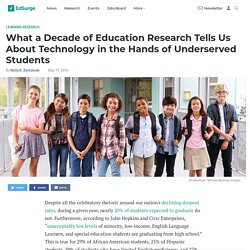
Furthermore, according to John Hopkins and Civic Enterprises, “unacceptably low levels of minority, low-income, English Language Learners, and special education students are graduating from high school.” This is true for 29% of African American students, 25% of Hispanic students, 39% of students who have limited English proficiency, and 27% of low income students (as shown on Ed.gov). Hardware can’t fill this digital divide—especially when K-12 schools in low-income neighborhoods are only using it for remediation purposes. In the last three years, U.S. schools have begun seeing an unprecedented level of new hardware and software in their classrooms.
How Access to Technology Can Create Equity in Schools. When used effectively, technology can greatly contribute to creating equity in schools.

It removes barriers to learning materials, supports students where they are across varied learning contexts and needs, and gives educators more insight into the learning environments they’re creating. Educational Technology Serves Equity When Used with Purpose. In my time as a classroom teacher, principal and superintendent, I became professionally and emotionally vested in leading and supporting a vision for educational equity, which is shared by many of my colleagues.

That vision is to create the best conditions that can lead to equitable learning outcomes and to provide all students with the right resources they need to learn, regardless of race, gender, income and other factors. I was fortunate to lead teams that shared my passion for achieving educational equity, but I was also humbled by the challenges presented on this path. Advocating for changes that would uproot the foundation of long-standing institutions, policies and practices can quickly begin to feel like an uphill battle, no matter how many educators are working for the cause.
As I ventured into new roles and collaborated with policy makers, edtech developers, teacher trainers and thought leaders, my approach and enthusiasm for this vision expanded. A United Vision. It’s Time Edtech Conferences Stopped Ignoring Equity and Race. The typical edtech conference buzzes with gadgetry, infrastructure and new ways to engage students.
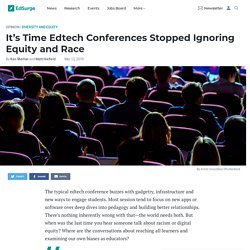
Most session tend to focus on new apps or software over deep dives into pedagogy and building better relationships. There’s nothing inherently wrong with that—the world needs both. But when was the last time you hear someone talk about racism or digital equity? Where are the conversations about reaching all learners and examining our own biases as educators? Most tech conference attendees don’t stop to consider the institutions, such as racism and complicity that create the inequities their students deal with. *A Copyright-Friendly Toolkit. However fabulous Creative Commons and Public Domain content may be, sometimes you really need to use copyrighted material.
Say you plan to comment on popular media or current events. *Renee Hobbs - Copyright Clarity: How Fair Use Supports Digital Learning. *Fair use and transformativeness: It may shake your world. I am no longer sure that anything I learned, or anything I regularly share relating to fair use, is either helpful or relevant.
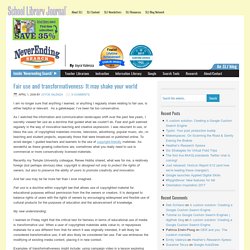
*Scope & Sequence: Common Sense K-12 Digital Citizenship Curriculum. Get Trained Use our professional development resources to learn best practices for teaching digital citizenship to your students.
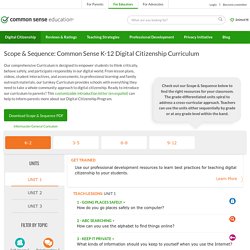
Fair Use - Copyright for Libraries - LibGuides at American Library Association. Please note that ALA cannot give legal advice. If you need legal advice, you should contact an intellectual property attorney. The Fair Use Doctrine provides for limited use of copyrighted materials for educational and research purposes without permission from the owners. It is not a blanket exemption. Instead, each proposed use must be analyzed under a four-part test. A Fair(y) Use Tale. Fair Use Evaluator. Tool for Supporting the Fair Use Reasoning Process. How to Teach Copyright and Fair Use to Students. What does it look like to prepare students to navigate the digital world? This is a question I often tackle in both in my own moments of brainstorming and searching for new resources to share, as well as in conversations with fellow educators.
Finding the right resources for teaching students the basics of copyright— including its limitations such as fair use—is essential. We want to make sure students are prepared to work and create in digital and traditional spaces, too. Both the ISTE Standards and the American Association of School Librarians Standards for the 21st Century Learner address the issues of preparing students to navigate and create in a digital world.
Intellectual Property Part 1. Intermediate Web Literacy I: Intro to CSS. Do the activity on your own to become familiar with fair use, open licensing, copyright, search, reverse-image search, and embedding images in a webpage. Follow this link to the Thimble project for this activity. Click on the green "Remix" button in the upper right-hand corner of the window to go into the project's code. Click on the "Tutorial" pane next to the "Preview" pane in the upper right-hand corner of the coding window. Follow the steps in the tutorial to complete the activity. When we share, everyone wins. Choose a License.
This work is licensed under the Creative Commons LICENSE_NAME License. To view a copy of this license, visit LICENSE_URL. We are currently testing a new version of the License Chooser. Please consider using the Chooser beta, and leave us feedback on how we can improve. Creative Commons is a non-profit organization. We need your support to continue providing these tools.
Lorem ipsum dolor sit amet... About earlier versions. Recut, Reframe, Recycle - Center for Media and Social Impact. When college kids make mashups of Hollywood movies, are they violating the law? Not necessarily, according to the latest study (PDF) on copyright and creativity from the Center and American University’s Washington College of Law. The study, Recut, Reframe, Recycle: Quoting Copyrighted Material in User-Generated Video, by Center director Pat Aufderheide and Peter Jaszi, co-director of the law school’s Program on Information Justice and Intellectual Property, shows that many uses of copyrighted material in today’s online videos are eligible for fair use consideration. Codes Archives - Center for Media and Social Impact. Even Weird Al Gets Permission – American University Intellectual Property Brief. If you’re on the Intellectual Property Brief website, odds are that you know what fair use is.
The doctrine of fair use is one of the most important features of United States copyright law, and the need for its preservation cannot be overstated. FindingCC0images - Symbaloo Gallery. Common Sense Education. Be Internet Awesome (Google) Google BeInternetAwesome DigitalCitizenshipSafety Curriculum.
Nerdy Birdy Tweets. Protect Your Students' Data and Privacy. Quick Privacy Checks Anyone Can Do: Tutorial Video and Student Worksheet. The Heart of Digital Citizenship. More Information on Fair Use. Fair use is a legal doctrine that promotes freedom of expression by permitting the unlicensed use of copyright-protected works in certain circumstances. Section 107 of the Copyright Act provides the statutory framework for determining whether something is a fair use and identifies certain types of uses—such as criticism, comment, news reporting, teaching, scholarship, and research—as examples of activities that may qualify as fair use.
Section 107 calls for consideration of the following four factors in evaluating a question of fair use: Best practices for attribution. You can use CC-licensed materials as long as you follow the license conditions. One condition of all CC licenses is attribution.